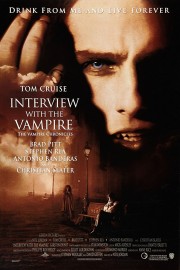Interview With the Vampire
In the 20 years since it’s release, “Interview With the Vampire” has aged beautifully into one of the great, Gothic horror films of the modern age. Based on the most famous of Anne Rice’s Vampire Chronicles novels, it was a strange convergence of moments in the careers of many people that shouldn’t have really worked, but my God, it is a classic vampire film in the tradition of “Dracula,” “Nosferatu,” and “Horror of Dracula.” The romanticism of the narrative can be a bit much at times, but because everyone involved with the production is so committed to the ideas in the film, it works strikingly well.
I remember when Tom Cruise was announced for the role of Lestat. Readers, led by author Rice, could not stand for it. The uproar didn’t really let up until people started to see his performance as the beloved vampire, who, in this story, ushers in a widowed plantation owner called Louis (Brad Pitt) and an orphaned young girl named Claudia (Kirsten Dunst) into his world of darkness. Lestat isn’t the star of this story, though; the vampire being interviewed in this movie is Louis, and this was the moment when Pitt really came into the consciousness of moviegoers (his star turn in “Legends of the Fall” later in the winter sealed his fate as a box-office draw). Coupled with Cruise’s star power, and Pitt’s rising star, the violent, R-rated “Vampire” became one of 1994’s biggest hits, and arguably, the riskiest one to come out of the studio system that year.
Cruise and Pitt are the anchors of the film on-screen, though the rest of the actors more than hold their own. As Claudia, Dunst is breathtaking in what is still one of her finest performances. Later, when Louis and Claudia go to Paris, they come across other vampires at last: their leader, Armand, is played by Antonio Banderas, and seems like the mentor to Louis that Lestat could never be; and Santiago, played by Stephen Rea, is a vicious, comedic henchman who plays host to a brutal vaudeville theatre where death on stage is eternal. As the interviewer, we have Christian Slater, playing a role originally intended for River Phoenix, who died shortly before production, and Slater does a fine job as the audience’s perspective in the film; a thankless role, to be sure, but an important one for the moviegoer. Yes, there are times when some of these actors go a bit over the top, but outside of the two versions of “Nosferatu,” how many on-screen vampires haven’t? None of them reach the grating awfulness of “Van Helsing’s” Dracula, so they’re all good in my book.
While the actors eat up the Rice’s prose on-screen, director Jordan and his behind-the-scenes collaborators give it a haunting purpose with their production work. The “Crying Game” director, who followed that Oscar winner up with this film, creates a stunning atmosphere of dreadful life around Louis. Whereas Lestat is comfortable with the aristocracy, and loves the hunt, Louis is racked with guilt; for much of the movie, his diet is almost exclusively of rats. That duality between thriving on death, and being in agony because of it, is captured beautifully in the production design by Dante Ferretti (“Gangs of New York,” “Kundun”), and the costumes by Sandy Powell. Both elements are seen with a lush, sinister eye for composition by cinematographer Philippe Rousselot, and it’s all topped off by a rich classical score by Elliot Goldenthal, one of his finest efforts. This is a great example of every element of cinema coming together to create a complete moviegoing experience that works on both an aesthetic and emotional level, and it’s hard to argue that “Interview With the Vampire” is, indeed, that.










